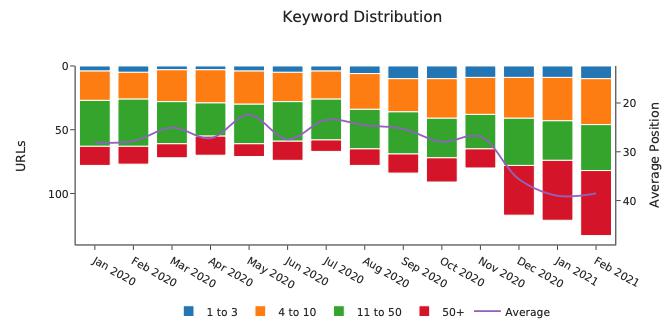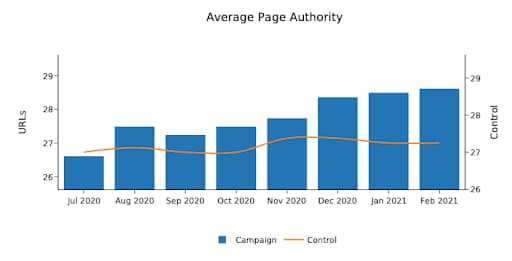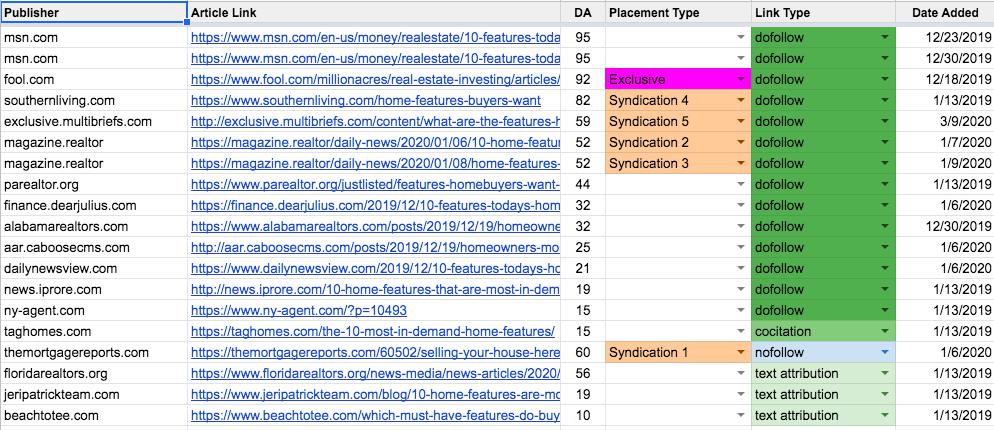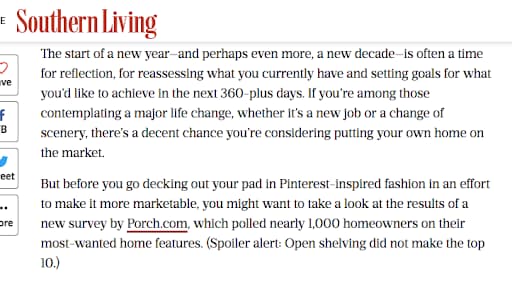Now that you've made it through the Beginner's Guide to Link Building, you might be wondering how experienced SEOs put their skills into action. We've compiled anecdotes and advice from seasoned link builders to offer a glimpse of how this work looks in practice. Read on!
Link reclamation for enterprise-level site migration
My favorite link building tactic is link reclamation. Often best on large websites after migrations or post-acquisition, the process begins by finding links to the old website. Organize them by "best" links first and begin outreach!
We ran this in 2020 for an enterprise-level client migrating a lesser brand over to the primary brand’s domain. It's taken a massive amount of coordination between our two companies: identifying the highest value pages on their website; pulling and organizing the best links to reclaim across hundreds of thousands of backlinks; and implementing outreach across 5 team members to ensure compliance and that work isn’t duplicated. But it's been a success! To date, we've reclaimed nearly 300 links across 52 product pages, with the client experiencing minimal negative impact from their migration along the way.
Some brands see this as less valuable. Why not implement a 301-redirect and count the link equity this way? Because SEO is about optimization. Post-migration or acquisition is the ideal time to ask for your preferred anchor text along with an ask to point the link directly to the most relevant product or converting page.
Colby Stream, Page One Power
Build better links with Moz Pro
Creative thinking and link outreach
Every functional link building tactic earns its links by meeting the publisher’s unstated "price" for reaching their audience. In the earned link space, we’re talking about supplying publishers with value such as exclusive news and information, useful advice, articles that could help them sell more products or services, and useful corrections that shore up authority.
I’m reminded, as we discuss value exchange, of a campaign by the great link builder Debra Mastaler in which she offered a client t-shirt to the members of several dues-supported professional organizations. She not only earned links from the organization websites (who got to provide a "special perk" to their members), but earned business and of course brand visibility within their precise target audience. Wow!
While a free t-shirt may not work in all verticals, Mastaler reminds us of the most exhilarating aspect of link building: finding publishers who reach your target audience and asking "ok, what can we offer that they will actually want?" Creative, entrepreneurial thinking — perhaps you could call it marketing? — remains the link builder’s most important tactic.
Garrett French, Citation Labs
Measuring link performance using SEO-related metrics
This is one of the most challenging aspects of a campaign for myriad reasons.
It’s also one of the most effective ways to retain clients.
There are a number of ways to track the performance of a link-building campaign; which methods are chosen largely depends on the tactics deployed. In our case, we’re focused on the content side and specialize in earning placements to hard-to-link sales landing pages. We approach our measurements of success from the perspective of SEO-related metrics that will show both leading indicators of improvements and the right performance indicators once we have had impact.
Early on in a campaign, we often see a worsening of average position. The cause of this is typically new keywords ranking on the campaign page — because the page initially begins to rank on SERP #7 or #8, this will initially pull down the average rank of the page, even if the rank for established keywords is improving.
Master the Art (and Science) of Link Building

This graph underscores one of the risks of focusing too heavily on rank as the primary success metric. While average position (the purple line) shows a decline in average position, we can see in the stacked columns, that not only is the total number of ranking keywords growing, it’s also growing nicely in positions 1–3 (the blue segment at the top), as well as positions 4–10 (the orange segment 2nd from top). Just, not enough to keep up with newly ranking keywords further down in the SERPs.
Correlating ranking changes to ranking keyword count was paramount to continuing this campaign.
While we track and report on average position over time, we certainly don’t lead with it. Instead, we focus on metrics that more directly correlate to traffic and conversions, which positions us for demonstrating positive ROI of the campaign.
The metrics that matter for us are share of voice (a search volume-weighted CTR model) and Moz Page Authority.
Share of Voice
The benefit for us of prioritizing share of voice over ranking is that it normalizes dramatic shifts in time series reports based on ranking fluctuations from low-volume queries. Ranking reports as we all know, can be a serious roller coaster.
Share of Voice, on the other hand, aligns with an estimated traffic model, expressed as a percentage of total traffic for the keyword set.

As seen in the graph, we also include a control group: a second set of pages on the site that are not part of the campaign (and preferably not part of any concerted SEO effort). This second set of pages is chosen from similar sections of the site and from similarly ranking and traffic’d pages when possible, in order to measure the success of our link building campaign against.
While the above graph does indicate positive growth just with the bars, when we determine the percentage difference between our campaign pages and the control group, the results are even more dramatic.
| Sep 2020 | Oct 2020 | M/M | % diff | |
|---|---|---|---|---|
| Campaign | 4.62% | 5.53% | 19.7% | 2281.44% |
| Control | 4.43% | 4.39% | -0.9% |
Page Authority
Another critical metric is Moz Page Authority, which is often another early indicator of imminent success — we sometimes see Page Authority increase even before we see improvement to rankings and share of voice.

And again, tracking against a control group helps to underscore the value of our work.
| Results | |
|---|---|
| Average for all campaign pages | 0.46% |
| Average for all control pages | 0.02% |
| Difference | 2200.0% |
James Wirth, Citation Labs
Measure no-follow and co-citation links to tell the full story
We track the number of links earned, the type of links, the domain authority of those links, and more. We also differentiate between the links that we earned through pitching (noted as either "exclusive" or "syndication") and the ones resulting organically.
Here is an example of a project’s link results:

We explain to clients that link reports like this are good signs for the search algorithms, because natural syndication (as opposed to us pitching) often occurs when you get news coverage on legitimate news sites.
We make sure to keep tabs on nofollow links and co-citation links (which we define as links to the coverage of our content rather than the content itself), because we believe all of these are signals to Google of authority.
We also report on more qualitative results, like the number of times a brand is mentioned in an article, where the mentions occur, and how authoritatively they’re referenced.

For example, in this Southern Living coverage, we’d note that the client (Porch.com) was named in the second paragraph of the story.
Amanda Milligan, Fractl
Identifying link targets for niche markets
I’ve created linkable content to support link building efforts for a client who sold commercial signage. Making linkable content that appeals to many different readers is already somewhat difficult when working in such a narrow niche, and figuring out appropriate topics for this client was a challenge. They were protective of their brand, wanted to reach a certain audience, and had a particular vision for how their products and services should be represented in our content.
We had to scrap several of our original content ideas, decreasing the number of readers we could reach and sites we could target for links on their behalf. There’s always a delicate balance to strike between serving the client’s target audience and engaging a larger readership. Giving preference to one audience means making sacrifices with the other, and when creating linkable assets, I’m hesitant to alienate the readers we could reach through link building to hone in on a smaller, more qualified target audience.
This means we had to get more creative with ideating topics and considering link building opportunities — there’s always a relevant audience you can use content to connect with, even when you think there’s no way readers would be interested in that niche. Finessing some of our existing ideas and creating new assets from scratch resulted in some fresh and unique linkable content that would be more meaningful and valuable for our client, both in its relevance to their brand and ability to earn links.
Maddie Baker, SEO Content Creator
Relationship management and link outreach
Everything you’ve been working towards as part of your link building campaign has built up to the outreach; it’s the most nerve-wracking step in the process for a lot of us. But it doesn’t need to be.
Some of Aira’s most successful launches have delivered results because we never go to journalists or bloggers with our campaign out-of-the-blue or completely cold on launch day. Instead, in the run-up to the big day, we’ll work alongside our key contacts and start to 'warm them up' (#jargon!) and let them know what we’re working on and what they can expect from us in the next few weeks.
Doing this allows for two things:
Journalists, writers, and bloggers to make space for your story to be written on the day your campaign goes live
Journalists, writers, and bloggers to give you feedback ahead of time on the data, copy, or information you're sharing so you can provide them with everything they need to write the story up and include that all-important link
When you’re warming key contacts up, it’s also important not to just use email or phone outreach — you should try and follow them on social media, especially Twitter, and see what they cover and are interested in.
You can also find our what they’ve written about historically and use this to your advantage. This works especially well if you’re doing link building or digital PR in specific or niche fields.
For example, if you are working with a travel brand for their link building, spend time doing research on Buzzsumo to work out the top or trending articles and start to interact with the writers.
Remember, once you’ve started outreach and the coverage comes flying in for your campaign, if you haven’t been given a link, you can always ask for one in a polite manner. You might just get one!
Shannon McGuirk, Aira
Ready to rejuvenate your link building strategy?
From analyzing your link profile to uncovering new link opportunities, from identifying new and lost links to competitive analysis and more, Moz Pro does it all. Take a free trial today and see what you can achieve: